CAA News Today
Art Journal / AJO Editorial Board seeks new members!
posted by CAA — March 15, 2024
CAA invites nominations and self-nominations to fill two seats on the Art Journal / AJO Editorial Board for a four-year term: July 1, 2024–June 30, 2028. Candidates may be artists, art historians, art critics, art educators, curators, or other art professionals; institutional affiliation is not required. Art Journal, published quarterly by CAA, is devoted to twentieth- and twenty-first-century art and visual culture. AJO is an online forum for the visual arts that presents artists’ projects, conversations and interviews, scholarly essays, and other forms of original content. Committed to fostering new intellectual exchanges in the fields of modern and contemporary art, AJO prioritizes material that makes meaningful use of the web and publishes on a rolling basis.
The editorial board advises the Art Journal and AJO editors-in-chief and assists them in identifying authors, articles, artists’ projects, and other content for the journal; performs peer review and recommends peer reviewers; guides the journals’ editorial programs and may propose new initiatives for them; promotes and advocates for both journals; and may support fundraising efforts on their behalf. Members also assist the editors-in-chief to keep abreast of trends and issues in the field by attending and reporting on sessions at the CAA Annual Conference and other academic conferences, symposia, exhibitions, and events.
The Art Journal / AJO Editorial Board meets three times a year, with meetings in the spring and fall plus one at the CAA Annual Conference in February. The fall and spring meetings are currently held remotely. Members are expected to pay travel and lodging expenses to attend the conference in February. Members of all editorial boards volunteer their services to CAA without compensation.
Candidates must be current CAA members in good standing and should not be serving on the editorial board of a competitive journal or on another CAA editorial board or committee. Members may not publish their own work in the journals during the term of service. CAA encourages applications from colleagues who will contribute to the diversity of perspectives on the Art Journal / AJO Editorial Board and who will engage actively with conversations about the discipline’s engagements with differences of culture, religion, nationality, race, gender, sexuality, and access. Nominators should ascertain their nominee’s willingness to serve before submitting a name; self-nominations are also welcome. Please email a letter of interest and a CV as a single PDF to Eugenia Bell, Editorial Director.
Deadline: May 6
Pride Month and Art Journal Open
posted by CAA — June 08, 2022
This Pride Month, we highlight the rich scholarship and programs produced at CAA that center LGBTQ+ topics, as well as gender and sexual identity, in the fields of visual arts and the humanities. This week, we are sharing a bibliography of articles on these topics from our open-access journal Art Journal Open.
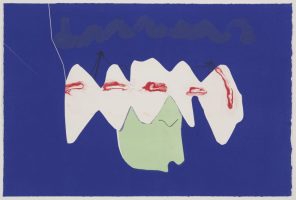 |
Downey, Kerry. “Creating Good-Enough Containers: Reflections on Queerness in Community-Based Museum Education.” Art Journal Open (January 9, 2019).
Kerry Downey, They said to the ocean, 2016, monotype with chine-collé, 19 x 13.5 in. Printed with Marina Ancona / 10 Grand Press. |
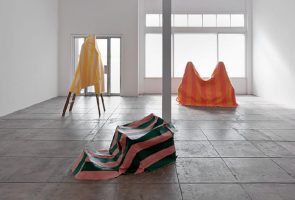 |
Doyle, Jennifer and David Getsy. “Queer Formalisms: Jennifer Doyle and David Getsy in Conversation.” Art Journal Open (March 31, 2014).
Math Bass, Body No Body Body, 2012, latex paint on canvas and wood, installation view, Overduin and Kite, Los Angeles, 2012 (artwork © Math Bass; photograph provided by Overduin and Kite) |
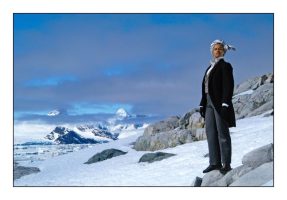 |
Getsy, David J. and Che Gossett, “A Syllabus on Transgender and Nonbinary Methods for Art and Art History.” Art Journal Open (February 4, 2022). Crossover article from Art Journal, 80, no. 4 (Winter 2021).
Del LaGrace Volcano, Moj of the Antarctic: On the Mountain, Antarctica, 2005, giclée print, 30 x 36 in. (76.2 x 91.4 cm) (artwork © Del LaGrace Volcano) |
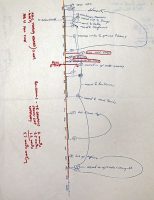 |
Latimer, Tirza True. “Introduction: Conversations on Queer Affect and Queer Archives.” Art Journal Open (October 24th, 2013). Crossover article from Art Journal 72, no. 2 (Summer 2013).
Veronica Friedman, Pages from monthly planners, 1980 and 1981. Veronica Friedman Papers, Gay, Lesbian, Bisexual, Transgender Historical Society, San Francisco (photograph © Barbara McBane) |
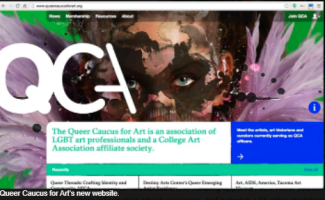 |
Queer Caucus for Art. “Update from the Queer Caucus for Art.” Art Journal Open (January 26, 2016). |
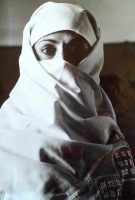 |
Rosa, Maria Laura. “Questions of Identity: Photographic Series by Alicia D’Amico, 1983–86.” Art Journal Open (July 2, 2019). Crossover article from Art Journal 78, no. 1 (Spring 2019).
Alicia D’Amico photograph of Liliana, a performance by Liliana Mizrahi, 1983, scanned copy of original negative, reproduction from original 35mm negative contact (photograph © Archivo Alicia D’Amico, Buenos Aires) |
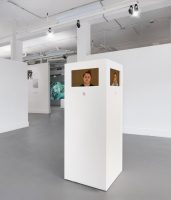 |
Shvarts, Aliza. “Toward a Reparative Pedagogy: Art as Trigger, Art as Repair.” Art Journal Open (April 7, 2022).
|
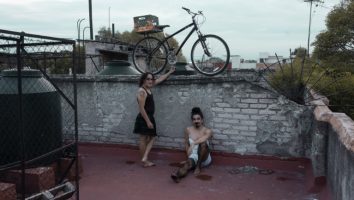 |
Whitener, Brian. “Transiting in Anti-Patriarchal Worlds: The Queer Photography of Fernando Fuentes.” Art Journal Open (November 18, 2021).
Fernando Fuentes, “Emma” (with Homero Emma Jimenez), 2020 (photograph by Constanza Moctezuma) |
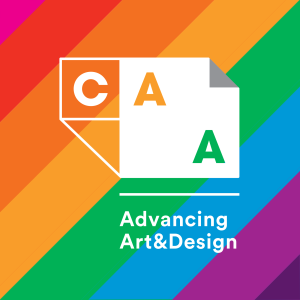
Women’s History Month and Art Journal Open
posted by CAA — March 21, 2022
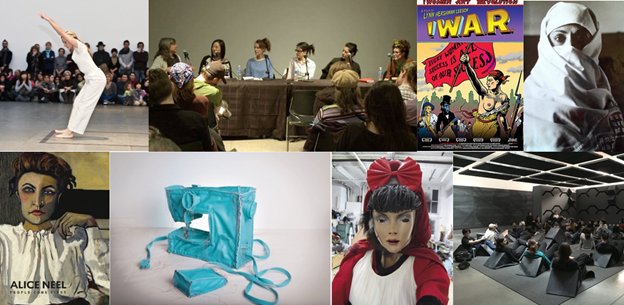
Each week this Women’s History Month, we highlight the rich scholarship and programs produced at CAA that celebrate women in the fields of visual arts and the humanities. This week, we are sharing a bibliography of articles from our open-access journal Art Journal Open that feature women artists.
This Women’s History Month is also especially significant this year, which is the 50th anniversary of feminism at CAA. To learn more about this history, visit this page. CAA is also collecting archival materials to better understand and document the history of its Committee of Women in the Arts, including the committee’s many collaborations with other affiliate committees and groups, such as the Women’s Caucus for Art, The Feminist Art Project, the Queer Caucus, and many more. Visit this page for more information.
 |
Andrew, Nell. “DadaDance: Sophie Taueber’s Visceral Abstraction.” Art Journal Open (July 3, 2014).
Sophie Taueber-Arp, Free Vertical-Horizontal Rhythms (Rythmes verticaux-horizontaux libres), 1919, gouache, 11 15⁄16 x 8 9⁄16 in. (30.3 x 21.8 cm). Stiftung Hans Arp und Sophie Taeuber Arp e.V., inv. 003.205 (artwork in the public domain; photograph provided by Stiftung Hans Arp und Sophie Taeuber Arp) |
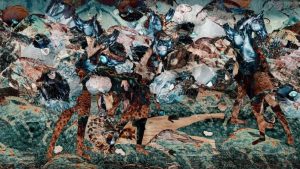 |
Barakeh, Zeina. “Projections for the Third Half [Cloud Storm].” Art Journal Open (August 6, 2020).
Zeina Barakeh, Projections From The Third Half [Cloud Storm], 2020, animation, 3 min. (artwork © Zeina Barakeh) |
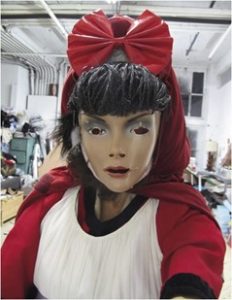 |
Barber, Tiffany E. “Narcissister, a Truly Kinky Artist.” Art Journal Open (March 11, 2020).
Narcissister, Red Riding Hood, 2014, mixed media (photograph provided by the artist) |
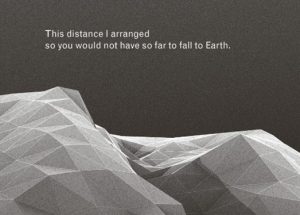 |
Berrigan, Caitlin and Sasha Engelmann. “Fault Lines and Fractures: A Conversation about Imaginary Explosions.” Art Journal Open (December 17, 2020).
Caitlin Berrigan, excerpt from Imaginary Explosions, 2018 |
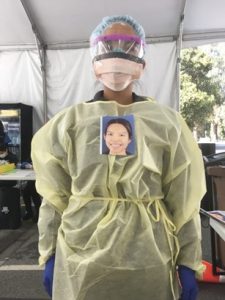 |
Bryan-Wilson, Julia and Mary Beth Heffernan. “Facing Social Practice: Mary Beth Heffernan in conversation with Julia Bryan-Wilson.” Art Journal Open (June 30, 2020).
Stanford Express Care nurse Anna Chico, who was among the first providers to use PPE Portraits for COVID-19 care, March 2020 (photograph by Cati Brown-Johnson) |
 |
Burns, A.K. and Melissa Ragain. “Scripting A Smeary Spot.” Art Journal Open (December 8, 2017).
The late Jack Doroshow performs as Mother Flawless, a clairvoyant psyche. In this scene she recites an excerpt from Joanna Russ’ sci-fi novel We Who Are About To. . . , A.K. Burns, video still from A Smeary Spot, 2015, four-channel video installation, HD color, six-channel sound, TRT 53:13 (artwork © A.K. Burns; image provided by the artist, Callicoon Fine Arts, NY, and Michel Rein Gallery, Paris/Brussels) |
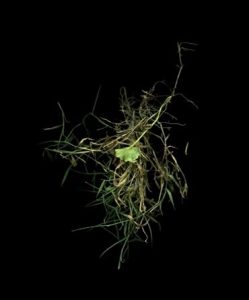 |
Cancelmo, Amy. “Roots and Ramble Kija Lucas and Amy Cancelmo in Conversation.” Art Journal Open (August 30, 2016).
Kija Lucas, Bristol 30, 2013, archival pigment print, 20 x 24 in. (50.8 x 60.9 cm), from In Search of Home, (artwork © Kija Lucas) |
 |
Carland, Tammy Rae and Ann Cvetkovich. “Sharing an Archive of Feelings: A Conversation.” Art Journal Open (October 24, 2013).
Tammy Rae Carland, Galz Living Room, MWMF, from Outpost, 2004, color photograph, 20 x 24 in. (50.8 x 61cm) (artwork © Tammy Rae Carland) |
 |
Costello, Kate. “P&P .” Art Journal Open (November 3, 2016).
Still from Kate Costello, P&P, 2016, video, 1 min., 26 sec. (artwork © Kate Costello) |
 |
Craycroft, Anna. “To Listen.” Art Journal Open (October 25, 2017).
Sophomore Seminar with Meg Cranston and Marlena Donohue, April 5, 2017: Meg Cranston and Marlena Donohue’s class met with Anna Craycroft to discuss Tuning the Room in relation to Umberto Eco’s essay “The Open Work.” (artwork © Anna Craycroft) |
 |
Craycroft, Anna. “To Record, to Interpret, to Comment.” Art Journal Open (March 1, 2017).
Anna Craycroft, The Earth Is a Magnet, 2016, installation view, part of The Artist’s Museum, Institute of Contemporary Art Boston, November 16, 2016–March 26, 2017 (artwork © Anna Craycroft; photograph by Charles Mayer) |
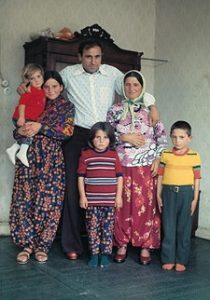 |
DaPonte, Amy A. “Candida Höfer’s Turken in Deutschland as ‘Counter-publicity’.” Art Journal Open (January 6, 2017).
Candida Höfer, Untitled from Türken in Deutschland 1979, 1979, color slide projection, 80 slides, approx. 7 min., dimensions variable (artwork © Candida Höfer, Köln/VG Bild-Kunst, Bonn 2016) |
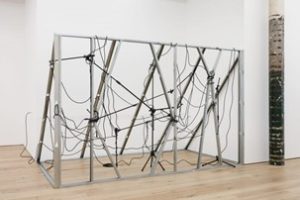 |
Fuenmayor, Jesús. “Barricades of Silence: Nikita Gale in Conversation with Jesús Fuenmayor.” Art Journal Open (August 20, 2020).
Nikita Gale, INTERCEPTOR, 2019, installation view, Fall Apart: Nikita Gale & Pat O’Neill, Martos Gallery, New York, January 11–February 24, 2019 (artwork © Nikita Gale; photograph by Charles Benton/Martos Gallery, provided by the artist) |
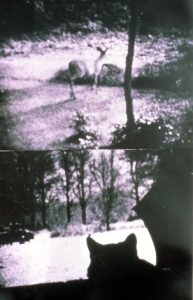 |
Goodeve, Thyrza Nichols. “The Cat is My Medium: Notes on Writing and Art of Carloee Schneemann.” Art Journal Open (July 29, 2015).
Carolee Schneemann, Kitch’s Last Meal, 1973–76, Super 8mm film, double projection, vertical, sound on cassette, ca. 5 hrs., two installation views (artwork © Carolee Schneemann; photographs provided by the artist) |
 |
Goulish, Matthew. “A Clear Day and No Memories: Neurology, Philosophy, and Analogy in Kerry Tribe’s HM.” Art Journal Open (February 5, 2014).
Eadward Muybridge, Pi-Wi-Ack, Valley of the Yosemite (Shower of Stars), “Vernal Fall,” 400 Feet Fall, No. 29, 1872, wet-plate collodion photograph (photograph in the public domain) |
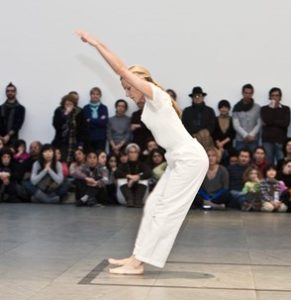 |
Graham, Amanda Jane. “Space Travels: Trisha Brown’s Locus.” Art Journal Open (July 22, 2016).
Trisha Brown, Locus Solo, 2011, performed by Diane Madden in “Performance 11: OnLine/Trisha Brown Dance Company” in conjunction with the exhibition On Line: Drawing through the Twentieth Century, Museum of Modern Art, New York, January 2011 (photographs © Yi-Chun Wu; photographs provided by Museum of Modern Art/Licensed by SCALA/Art Resource, NY) |
 |
Jenkinson, Monique. “Diva Maw.” Art Journal Open (October 29, 2020).
Monique Jenkinson (Fauxnique), Diva Maw, 2020, digital video, 5:35 min.; soundtrack by Marc Kate, Untitled (“Diva Maw” Soundtrack), 2020, audio file (video © Monique Jenkinson; soundtrack © Marc Kate) |
 |
Kauffman, Vanessa. “Outside of Time: Patricia Fernández Carcedo in Conversation with Vanessa Kauffman.” Art Journal Open (August 12, 2016).
Visitors in Patricia Fernández Carcedo’s studio during Headlands’ Fall 2015 Open House (artwork © Patricia Fernández Carcedo; photograph by Rebecca Puretz, provided by Headlands Center for the Arts) |
 |
Laser, Liz Magic and Christopher Y. Lew. “InterAct: a reenacted interview.” Art Journal Open (May 4, 2011)
Liz Magic Laser, Flight, 2010, performance, MoMA PS1, Long Island City, April 10, 2010 (artwork © Liz Magic Laser; photograph by Mia Tramz, provided by Derek Eller Gallery). The performance was developed in collaboration with actors Lindsey Andersen, Nic Grelli, Elizabeth Hodur, Michael Wiener, Max Woertendyke, and Lia Woertendyke |
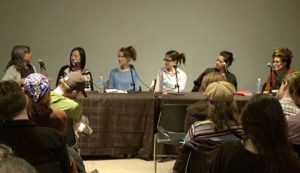 |
Lee, Young Jean. “Women in Downtown Theater.” Art Journal Open (August 26, 2012). |
 |
Leeson, Lynn Hershman. “Excerpts from the Graphic Novel !Women Art Revolution—A Secret History.” Art Journal Open (May 29, 2011) |
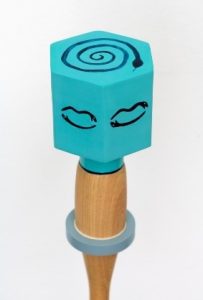 |
Mann, Elana. “One day I will make a mace, but for now I have a mouth.” Art Journal Open (September 30, 2021).
Elana Mann, Unidentified Bright Object #61, 2021, clay, wood, and glass, 14 ½ x 3 ½ x 3 ¾ in. (36.8 x 8.9 x 9.5 cm) (artwork © Elana Mann; photographs by Brica Wilcox) |
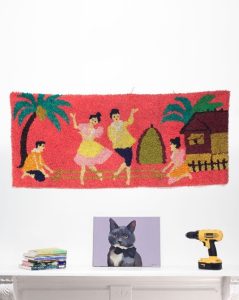 |
Masley-Charlet, Caitlin. “Caitlin Masley-Charlet in Conversation with Elisabeth Smolarz.” Art Journal Open (June 5, 2018).
Elisabeth Smolarz, ENCYCLOPEDIA OF THINGS, ongoing 2014–2017. Archival inkjet prints, dimensions variable. Courtesy of the artist. |
 |
Masley-Charlet, Caitlin. “Caitlin Masley-Charlet and Diana Shpungin in Conversation.” Art Journal Open (July 8, 2016).
Diana Shpungin, detail of A Break in One and Several Places, 2015, graphite pencil, horsehair broom, glazed porcelain and stoneware, 24 x 43 x 14 in. (60.9 x 109.2 x 35.5 cm) (artwork © Diana Shpungin) |
 |
McKee, C.C. “‘a salting of sorts’: Salt, Sea, and Affective Form in the work of Deborah Jack.” Art Journal Open (July 30, 2019).
Deborah Jack, SHORE, 2004, nylon screens, video projection, rock salt, reflecting pool, dimensions variable, installation view, Big Orbit Gallery, Buffalo, New York (artwork © Deborah Jack; photograph provided by the artist) |
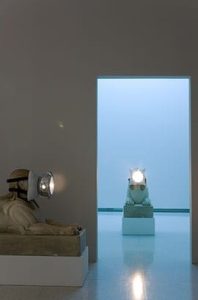 |
McClure, Michael Jay. “If it Need Be Termed Surrender: Trisha Donnelly’s Subjunctive Case.” Art Journal Open (July 29, 2013).
Trisha Donnelly, Untitled, 2008, plaster, horsehair, paint, pillow, belts, lamp, two parts, ea. 36 x 60 x 22¾ in. (91.4 x 152.4 x 57.8 cm), installation view, The Quick and the Dead, Walker Art Center, 2009 (artwork © Trisha Donnelly; photograph provided by Casey Kaplan, New York) |
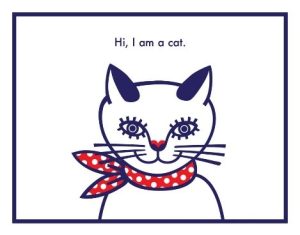 |
Ohsawa, Asuka. “Squares, Triangles, and Cats.” Art Journal Open (December 31, 2020). |
 |
Porges, Maria. “Shortest Stories.” Art Journal Open (December 20, 2018). |
 |
Rosa, María Laura. “Questions of Identity: Photographic Series by Alicia D’Amico, 1983–86.” Art Journal Open (July 2, 2019).
Alicia D’Amico photograph of Liliana, a performance by Liliana Mizrahi, 1983, scanned copy of original negative, reproduction from original 35mm negative contact (photograph © Archivo Alicia D’Amico, Buenos Aires) |
 |
Santos, Dorothy R. “ Domain Errors.” Art Journal Open (July 24, 2020). |
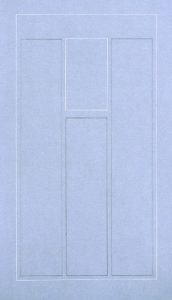 |
Schiff, Karen L. “Imprinting Agnes Martin.” Art Journal Open (December 19, 2014).
Karen L. Schiff, Agnes Martin, El País, 21 December 2004, II, 2005, graphite and stylus on vellum, 17 x 12 inches (artwork © Karen L. Schiff) |
 |
Sifuentes, Aram Han. “Official Unofficial Voting Station: Voting for All Who Legally Can’t.” Art Journal Open (October 1, 2020).
Protest Banner Lending Library, Let Us Vote! and Official Unofficial Voting Station, 2020, textile banners (photograph by Thaib A. Wahab) |
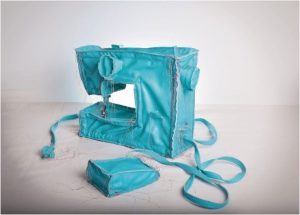 |
Szymanek, Angelique. “Haptic Encounters: Margarita Cabera’s Space in Between.” Art Journal Open (October 15, 2020).
Margarita Cabrera, Sewing Machine (Blue-Green), 2016, vinyl, thread, copper wire, and appliance parts (artwork © 2020 Margarita Cabrera/Licensed by VAGA at Artists Rights Society [ARS], NY; photograph provided by the artist) |
 |
Vlassopoulou, Penelope. “No water, Athens, Greece, 2015: Twenty-four hours with nothing to eat or drink, only smelling the jasmine.” Art Journal Open (October 26, 2016).
Excerpt from Pandelis Prevelakis, I Kefali tis Medousas [The Head of Medusa] (Athens: Friends’ Editions, 1963), trans. the artist and Markus Nystrom |
 |
Watt, Marie. “In Conversation with Marie Watt: A New Coyote Tale.” Art Journal Open (October 19, 2017).
Marie Watt, Blanket Stories: Transportation Object, Generous Ones, Trek, 2014, cast bronze, 18 x 4 x 6 ft. (5.49 x 1.22 x 1.83 m). Permanent installation, Tacoma Art Museum, Tacoma, Washington (artwork © Marie Watt; photograph by Benjamin Benschneider/OTTO) |
 |
Wilson, Siona. “Portraits (and) Matter.” Art Journal Open (January 13, 2022). |
 |
Yoshitake, Mika. “Humans have been Human for so long: Shana Lutker and Mika Yoshitake in Conversation.” Art Journal Open (August 2, 2016).
Shana Lutker, A handsome confused puppet, 2015, mirrored glass box, fluorescent lights, wood, marble, casters, 49 x 30 x 19 in. (124.4 x 76.2 x 48.2 cm) (artwork © Shana Lutker; photograph by Cathy Carver) |
 |
Yurshansky, Jenny. “Hide and Seek.” Art Journal Open (March 25, 2021).
Jenny Yurshansky, Hide and Seek (folded view), 2021, interactive sculpture, inkjet print, 3 3/4 x 3 3/4 x 3 in. (9.5 x 9.5 x 7.6 cm) (photograph provided by the artist) Folk tradition meets revisionist storytelling in Jenny Yurshansky’s printable sculpture |
CAA 2021: A look back on the past year’s programming, publications, and opportunities
posted by CAA — November 30, 2021
CAA has produced this reel with a compilation of events, scholarship, programs, and initiatives CAA from the last year. See below for a full list of each item (in order of appearance in the video) with links to learn more.
Programming:
CAA’s first virtual Annual Conference
Mariam Ghani in conversation with Laura Anderson Barbata
In Conversation with Dr. Nancy Odegaard
Theresa Avila, Annual Conference Program Chair in conversation with Meme Omogbai
An Inaugural Evening with CAA Distinguished Awardees and Artists
CAA Then & Now: Reflections on the Centennial Book and the Next Century
Karen Leader, author of Chapter 12: Advocacy
Opportunities:
Publication, travel, and support grants
Publications and Publications Programming:
Artist Project, Elana Mann for Art Journal Open
Roundtable discussion for Art Journal Open, Holding Space…
Art Journal and The Art Bulletin
caa.reviews book and exhibition reviews
caa.reviews’s dissertation roster, 2020
Global Programs
CAA-Getty International Program
CAA-Getty 10-Year International Program online publication
Podcasts
CAA Conversations by CAA’s Education Committee
CAA’s 110th Annual Conference will take place in Chicago from February 17-19, followed by virtual live sessions to be held in Zoom from March 3-5. For more information and to register go to this link.
Apply to Serve on CAA’s Editorial Boards!
posted by Allison Walters — February 19, 2021
This time of year, members have the opportunity to provide an important contribution to CAA’s four journals—either by serving as a volunteer member of an editorial board or by applying to be an editor-in-chief or reviews editor.
Below are 14 opportunities to help shape the editorial vision of CAA’s publications.
Any member may self-nominate for the following positions or (after ascertaining interest) nominate another member. For more information, please click on the links below. You may apply for more than one position. The deadline for all applications is April 15, 2021. Terms of service vary, but they all begin July 1, 2021.
The Art Bulletin: 2 Editorial Board members
The Art Bulletin: Editor(s)-in-Chief
Art Journal/AJO: 1 Editorial Board member
Art Journal: Reviews Editor
caa.reviews: 2 Editorial Board members
caa.reviews Council of Field Editors: 7 openings
Early Modern European Art (North)
Latin American Art
Medieval Art
Precolumbian Art
Exhibitions New York
Exhibitions Northwest US
Exhibitions Southeast US
An Interview with Nicole Archer, Editor-in-Chief of Art Journal Open
posted by CAA — June 15, 2020
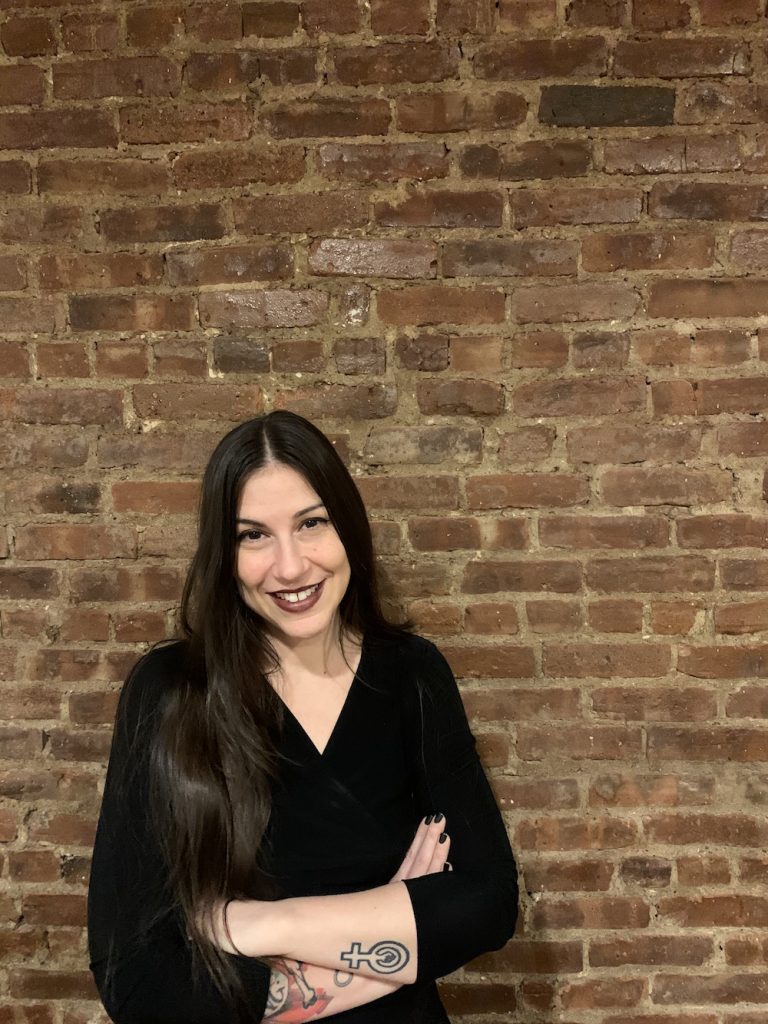
Nicole Archer.
We’re delighted to introduce readers to Nicole Archer, the current Editor-in-Chief of Art Journal Open (AJO), CAA’s online forum for the visual arts that presents artists’ projects, conversations and interviews, scholarly essays, and other forms of content from across the cultural field. Founded in 2012 as an open-access affiliate of Art Journal, Art Journal Open has been independently edited since 2014. It remains open access and is always free to explore.
Nicole Archer researches contemporary art and design, with an emphasis in textile and garment histories. She is an Assistant Professor in the Department of Art and Design at Montclair State University, where she extends this research through a teaching practice that encourages students to explore politics and aesthetics via close examinations of style, embodiment, and desire.
Amidst the end of the academic year, we corresponded with her over email to learn more about her research, her thoughts on the impact of COVID-19, and her aspirations for Art Journal Open.
Where are you from originally?
I was born in Brooklyn and raised mainly in South Florida, but I spent most of my adult life in San Francisco. In 2018, I returned to New York City.
What pathways led you to the work you do now?
My path has been shaped by a long line of committed feminist art historians, theorists, and activists who have inspired me to pursue work that is wildly curious, ethically responsible, and politically committed to issues of social justice. This, coupled with the fact that I started my college career in the mid-1990s, when the field of Visual Studies was demanding that Art History be held accountable for the role it played in supporting certain cultural hegemonies. It was a time when we were recognizing the benefit that many art historical methods could bring to critical cultural studies (and vice versa).
When did you first become a CAA member?
I have been a CAA member since 2011, but I was an avid reader of Art Journal and The Art Bulletin long before that (thanks to my library access).
What are you working on or thinking about currently?
I am currently finishing a book manuscript that considers how textiles (our key mediums of comfort and security) have been strategically manipulated over the last two decades to aid in the systematic reshaping of what constitutes “legitimate” versus “illegitimate” forms of state violence. The book tells interwoven, materially grounded stories regarding global arts and design practice, on the one hand, and military, police, and governmental action, on the other, to theorize how feelings of insecurity are produced, aesthetically.
What are your thoughts on the impact of COVID-19 on the work you do? On the field?
I think the current pandemic makes two things particularly clear. First, it highlights the important role that art and design can play in helping a society understand (and bear) emergent and acutely difficult circumstances. From movie marathons, artist talks, and book readings that we have enjoyed during our nights spent ‘sheltering in place,’ to the protest banners, photographs, and balcony performances that have led our communities towards acts of collective care and solidarity with one another.
Second, COVID-19 puts the varied inequities that underwrite the field in high relief. It makes the economic precarity of so many cultural workers glaringly obvious, and it forces us to recognize how undervalued cultural work actually is. We need to ask why we have allowed the arts to become so defunded and privatized (despite the social value it clearly delivers). Calls for austerity are circulating, and we know this means further cuts to already underfunded public arts initiatives. We need to resist this and seize this moment as an opportunity to insist on our value. We need to stop undercutting ourselves and our peers, and refuse to accept the exploitation of adjunct professors and graduate student teachers. We must do this as we push against the increasingly prohibitive costs of arts education.
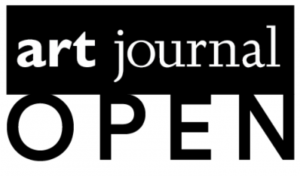 What led you to be interested in working on Art Journal Open?
What led you to be interested in working on Art Journal Open?
It is our shared responsibility, as arts and design professionals, to constantly “check” our field of practice—to find time to celebrate what we are doing well, and to redress and learn from our shortcomings. I believe this responsibility is a cornerstone of AJO’s editorial mission. Working on AJO is a unique opportunity to hold myself, and others, accountable on this front.
What is your vision for Art Journal Open during your tenure?
I hope to build on the solid foundation laid by the journal’s previous editors, and to further emphasize the open dimension of the publication’s identity—to treat “Open” as a verb, a call to action. We hope to accomplish this by leveraging the journal’s digital format, to open space for more multi-media Creative Projects, and to take advantage of our lack-of-paywall to help draw new readers to AJO and new voices to CAA.
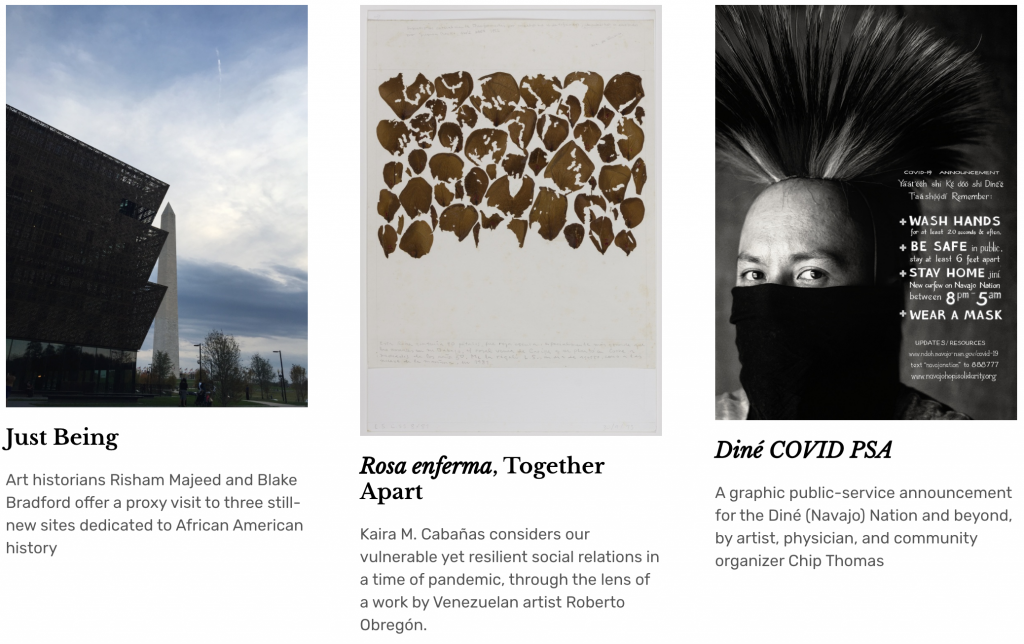
The first three pieces published after Nicole Archer fully took over as Editor-in-Chief of Art Journal Open.
What would you say is your top arts-related recommendation (book, website, resource) at the moment?
I know I am late to this, but I recently found an online radio station called NTS and it is giving me life! I miss trusting my night to a DJ, hearing a new song out of nowhere, and dancing with strangers. I am also tired of soundscapes controlled by algorithms. People should give it a listen in their studios and kitchens, and at their computers and writing desks.
View this post on Instagram
A favorite artwork?
Last year, I had the opportunity to see Sonya Clark’s Monumental Cloth, The Flag We Should Know at the Fabric Workshop and Museum in Philadelphia, and I have not been able to stop thinking about it since. Clark’s work epitomizes the important role art can play in ensuring that political discourse maintains its complexity in the face of a mediascape set on transforming these conversations into flat lines in the sand.
At the center of the exhibit was a monumental replica (15’x30’) of a white dish towel waived by Confederate troops in April 1865, before General E. Lee negotiated the terms of the Confederacy’s surrender. Displayed in a manner akin to the Star Spangled Banner (a centerpiece of the Smithsonian National Museum of American History’s collection), Monumental Cloth presented the Confederate Truce Flag as testament to a decisive moment in US history. It demanded that we ask why we do not know this flag, as a means to discuss anti-Blackness and the persistence of white supremacy in the United States. It provided a poignant, aesthetic counterstrategy to other manners of “memorializing” the Confederacy. The exhibit offered spaces of contemplation alongside opportunities for direct action—by setting-up looms that visitors could use to weave additional Truce Flag replicas, in opposition to the endless flow of commercially produced items made to bear the image of the Confederate Battle Flag.
What are you looking forward to?
Honestly, I am looking forward to the end of the Trump presidency, and to the possibility that the moment we are in could force real political and cultural change; that conversations around universal basic income and healthcare will gain traction, and that widespread recognition of the systemic racism inherent in the criminal justice system will open the door to both abolishing the prison system and defunding and demilitarizing the police that tyrannize communities of color in the US.
NICOLE ARCHER BIOGRAPHY
Nicole Archer researches contemporary art and design, with an emphasis in textile and garment histories. She is an Assistant Professor in the Department of Art and Design at Montclair State University, where she extends this research through a teaching practice that encourages students to explore politics and aesthetics via close examinations of style, embodiment, and desire.
Her work has been published in various journals, edited collections, and arts publications, including: Criticism: A Quarterly Journal for Literature and the Arts; Textile: The Journal of Cloth and Culture; Trap Door: Trans Cultural Production and the Politics of Visibility (published by the New Museum + MIT Press); Where are the Tiny Revolts? (published by the CCA Wattis Institute for Contemporary Arts + Sternberg Press); Women and Performance: A Journal of Feminist Theory.
Deadlines extended! Serve on a CAA Committee or Editorial Board
posted by CAA — January 27, 2020
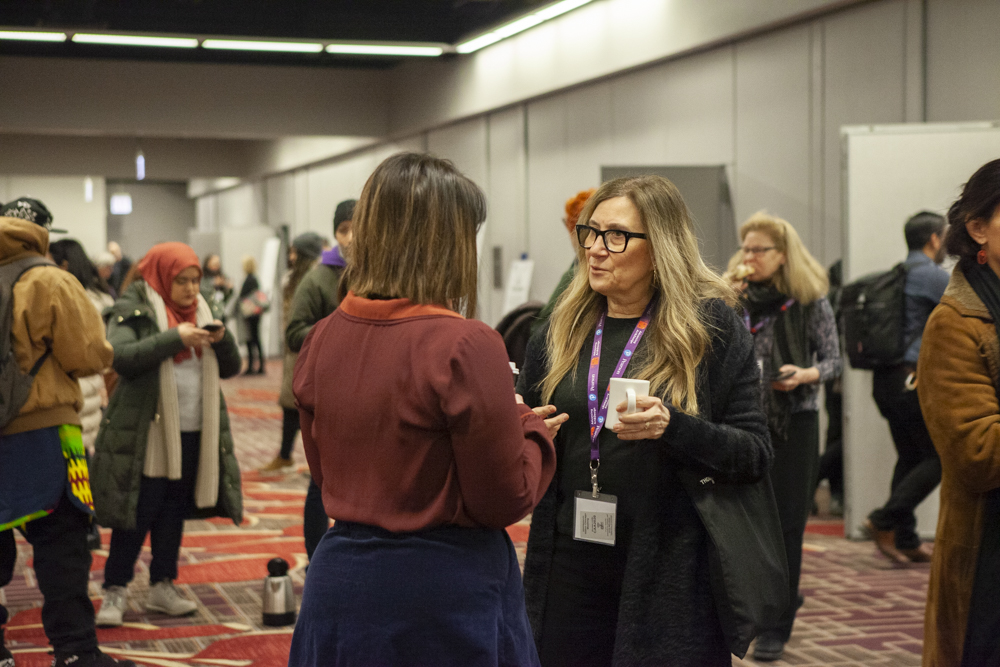
Attendees at the 2020 Annual Conference in Chicago. Photo: Stacey Rupolo
Each spring, members have the opportunity to provide crucial service to the field and gain an inside view by volunteering to work on a CAA committee or editorial board.
Any member may self-nominate for the following positions or (after ascertaining interest) nominate another member. For more information, please click on the links below.
CURRENT OPPORTUNITIES
Art Journal—Editor-In-Chief
Deadline (extended): June 1, 2020
caa.reviews—Field Editor for East Asian Art
Deadline (extended): June 1, 2020
Publications Committee—Two Members
Deadline (extended): June 1, 2020
PAST OPPORTUNITIES
Art Journal / Art Journal Open (AJO) Editorial Board—Three Members
Deadline: April 15, 2020
The Art Bulletin Editorial Board—One Member
Deadline: April 15, 2020
The Art Bulletin—One Reviews Editor or Coeditor Team
Deadline: April 15, 2020
caa.reviews Editorial Board—Three Members (One an Emerging Professional)
Deadline: April 15, 2020
caa.reviews—Eight Field Editors
African Art, African Diaspora/African American Art, Architecture and Urban Planning, Asian Art, Contemporary Art, Exhibitions: East Coast, Exhibitions: Midwest, Exhibitions: West Coast
Deadline: April 15, 2020
Serve on a CAA Editorial Board, Committee, or Jury
posted by CAA — March 20, 2019
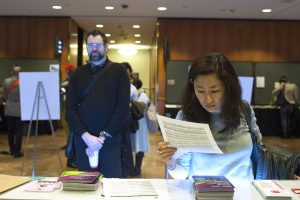
Attendees at the 2019 Annual Conference in New York. Photo: Ben Fractenberg
Each spring, members have the opportunity to provide critical service to the field and gain an inside view by volunteering to work on a CAA editorial board, committee, or jury.
Any member may self-nominate for the following positions or (after ascertaining interest) nominate another member. For more information, please click on the links below.
CURRENT OPPORTUNITIES
All deadlines for 2019 have passed.
CLOSED OPPORTUNITIES
Art Journal Open—Editor-in-Chief
Deadline: April 1
caa.reviews—Editor-in-Chief
Deadline: April 1
caa.reviews—Four Field Editors
Design History, Eighteenth-Century Art, Architecture and Urbanism, Theory and Historiography
Deadline: April 15
The Art Bulletin—Editorial Board Members
Deadline: April 15
Annual Conference—CAA Council of Readers
New this year, we’re asking members to serve a crucial role in shaping conference content.
Deadline: April 18
Annual Conference—Annual Conference Chair
Deadline: April 29
Annual Conference—Awards for Distinction Juries
Deadline: May 13
Millard Meiss Publication Fund—Jury Members
Deadline: May 13
Professional Development Fellowships in Art History and Visual Art—Jury Members
Deadline: May 13
Professional Committees—Seeking New Members
Committees: Design, Diversity Practices, Intellectual Property, Women in the Arts, Education, International, Museum, Professional Practices, Services to Artists, Student and Emerging Professionals
Deadline: September 18
Editor-in-Chief Sought for Art Journal Open
posted by CAA — December 17, 2018
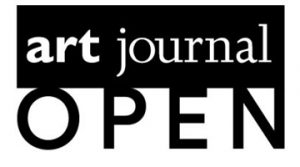
The Art Journal Editorial Board invites nominations and self-nominations for the position of editor-in-chief of Art Journal Open for the term of July 1, 2020–June 30, 2023 (with service as incoming editor designate, July 1, 2019–June 30, 2020). A candidate may be an artist, art historian, critic, educator, curator, or other professional within the membership served by CAA; institutional affiliation is not required. Art Journal Open is an online forum for the visual arts that presents artists’ projects, conversations and interviews, scholarly essays, and other content from across the cultural field. The independently edited journal publishes original material by artists, scholars, teachers, archivists, curators, critics, and other cultural producers and commentators, with a commitment to foster new intellectual exchanges about contemporary art and culture. Art Journal Open prioritizes material that makes meaningful use of the web, such as multimedia formats and techniques, and is published on a continual, rolling basis.
The editor is responsible for commissioning all content for Art Journal Open. He or she solicits or commissions projects, texts, and time-based content by artists and other authors, and determines the appropriate scope and format of each project. Working in consultation with the Art Journal editor-in-chief, reviews editor, and editorial board, the editor determines which pieces should undergo peer review and subsequent revision before acceptance. The editor also works with authors and a CAA staff editor on the development and preparation of materials for publication. The editorial board expects that a significant portion of the journal will be geared to work or concerns of artists, and that the editor will endeavor to give voice to underrepresented perspectives. Qualifications for the position include a broad knowledge of current art, the ability to work closely with artists in a wide variety of practices, and experience in developing written and other content for arts platforms. The position includes membership on the editorial board and, after the orientation period, an annual honorarium, paid quarterly for the three years the of the editorship. The editor attends the three meetings each year of the Art Journal Editorial Board and, as an ex-officio member, of the Publications Committee—held in New York or by teleconference in the spring and fall, and at the CAA Annual Conference in February—and submits an annual report to CAA’s Board of Directors.
Candidates must be current CAA members and should not serve concurrently on the editorial board of a competitive journal or on another CAA editorial board or committee. The editor-in-chief may not publish her or his own work on Art Journal Open or in Art Journal during the term of service. Nominators should ascertain a nominee’s willingness to serve before submitting a name; self-nominations are also welcome. Please send a letter describing your interest in and qualifications for the position, a CV, and at least one letter of recommendation to: Art Journal Open Editor Search, CAA, 50 Broadway, 21st floor, New York, NY 10004; or email the documents to Heather Holmes (hholmes@collegeart.org), CAA Associate Editor for Digital Publications.
Deadline: April 1, 2019; finalists will be interviewed on May 2 in New York.
Intimacy, Distance, and Disavowal in Art Publishing: Conversations with Dushko Petrovich
posted by CAA — September 12, 2018
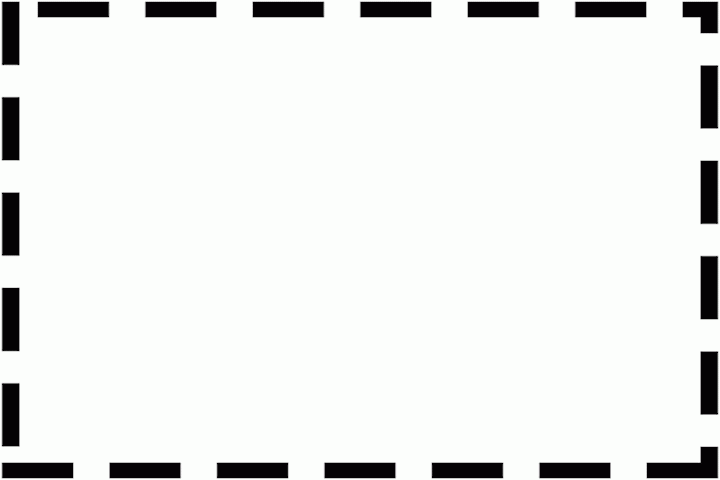
Hyperallergic‘s original piece included these graphics in lieu of reproducing contested images. Image via Hyperallergic.
In June of 2018, Hyperallergic published a two-part essay by the art historian and critic Steven Nelson about the rejection of his essay about artist Deana Lawson by both Aperture and frieze. In “Intimacy, Distance, and Disavowal in Art Publishing: Conversations with Dushko Petrovich,” arts journalist Dushko Petrovich dissects the situation piece by piece, interviewing representatives from Hyperallergic, frieze, Deana Lawson’s gallery, and Nelson himself. What emerges is a document of the processes that generally don’t get recorded when pieces of arts journalism are rejected or shelved, and what factors into these editorial decisions. Read more on Art Journal Open.


